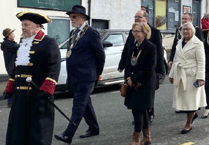For the first time in its 400-year history, one of Europe’s most spectacular historic ceilings, depicting dozens of Biblical scenes, birds, and mythical beasts, is undergoing full conservation and repair.
At 35 metres (116 feet) long, the barrel-vaulted ceiling of the Long Gallery at the National Trust’s Lanhydrock will take experts months to clean centuries’ worth of dirt and discolouration and to carry out intricate repairs.
Instead of doing so behind closed doors, however, they are inviting visitors to climb a purpose-built scaffold to see the full length of the Long Gallery ceiling up close and watch the conservators at work.
Plymouth University has used the latest technology to capture images of the impressive ceiling in minute detail, including a fingerprint of an original craftsman — these images will support their work as they painstakingly repair the magnificent work.
Created for Lanhydrock’s former owner, John Robartes, between 1620 and 1640, the ceiling is a masterpiece of Jacobean plasterwork, thought to be the work of the Abbott family of Frithelstock near Bideford.
It is likely that John Robartes and the craftsmen took inspiration from manuscripts in his library and from printed drawings.
Comprising 24 panels with scenes from the Old Testament Book of Genesis, including Adam and Eve, Noah and the Ark, the Life of Jacob, and David and Goliath, they are surrounded by more than 350 different species of animals, as well as intricately moulded plants and mythical beasts.
The craftsmen used press moulds to produce plaster casts as well as modelling decorative features by hand. They used a wooden sledge to ‘run mould’ the decorative features like cornices onto the ceiling.
Charlotte Newman, Lanhydrock’s Collections and House Manager, explains: “The Long Gallery ceiling is an extraordinary progress through some of the most familiar scenes in the Old Testament, surrounded by dozens of birds, snakes, fish, plants, and all manner of exotic and mythical creatures: crocodiles, porcupines, centaurs, unicorns. That all this is still here today is remarkable because the ceiling miraculously survived a devastating fire that destroyed two wings of the house at Lanhydrock in 1881.
“With many years of monitoring it, however, conservation work is now needed. The plaster has been showing cracks, flaking and discolouration.
“Specialists from Cliveden Conservation will repair the intricate plaster by filling cracks, replicating any lost plaster, washing off the old and discoloured distemper, and reapplying a new layer of distemper to restore the ceiling to its original appearance.”
Peter Bokody, an Associate Professor of Art History at Plymouth University, has been working with the team at Lanhydrock to research and document the ceiling
He said: “The ceiling is an extraordinary example of craftsmanship. Very little of its age, scale and intricacy survives anywhere in Europe, so it’s a joy to be able to work on it.
“Although we don’t have written evidence for who made it, it is highly probable it was crafted by the Abbott family workshop, and really is an incredible reflection of the skill and creativity of local people in the 17th century.”
Peter has worked as part of a team from Plymouth University to use the latest technology to scan and photograph the ceiling.
“We can capture an amazing level of detail in these scans,” he added. “We’ve taken hundreds of photos to create a 3D model of the ceiling, as well as using LiDAR, which uses lasers to capture minute details, even down to the fingerprint left on a mould by one of the original craftsmen.”
The Long Gallery, which contains the National Trust’s most important library, was emptied of furniture and more than 3,400 books so that work could start on the ceiling.
These objects are now stored along the route to the Long Gallery, giving visitors a unique chance to see the collection more closely.
An exhibition has been created through the house at Lanhydrock, where visitors can discover what it takes to start a conservation project on this scale, see the LiDAR scans, and how the property’s extensive collections are cared for while the work takes place.
Charlotte continued: “This is a once-in-a-lifetime opportunity for visitors to witness such a large-scale conservation project in action.
“Whether you are on the scaffold or enjoying it from ground level, you can be sure few people have seen this Jacobean plasterwork in as much detail since the talented craftsmen first completed it four centuries ago.”
The Long Gallery, scaffold tower and exhibition open to visitors from Friday 1 March.
For further information and opening times visit www.nationaltrust.org.uk/lanhydrock




